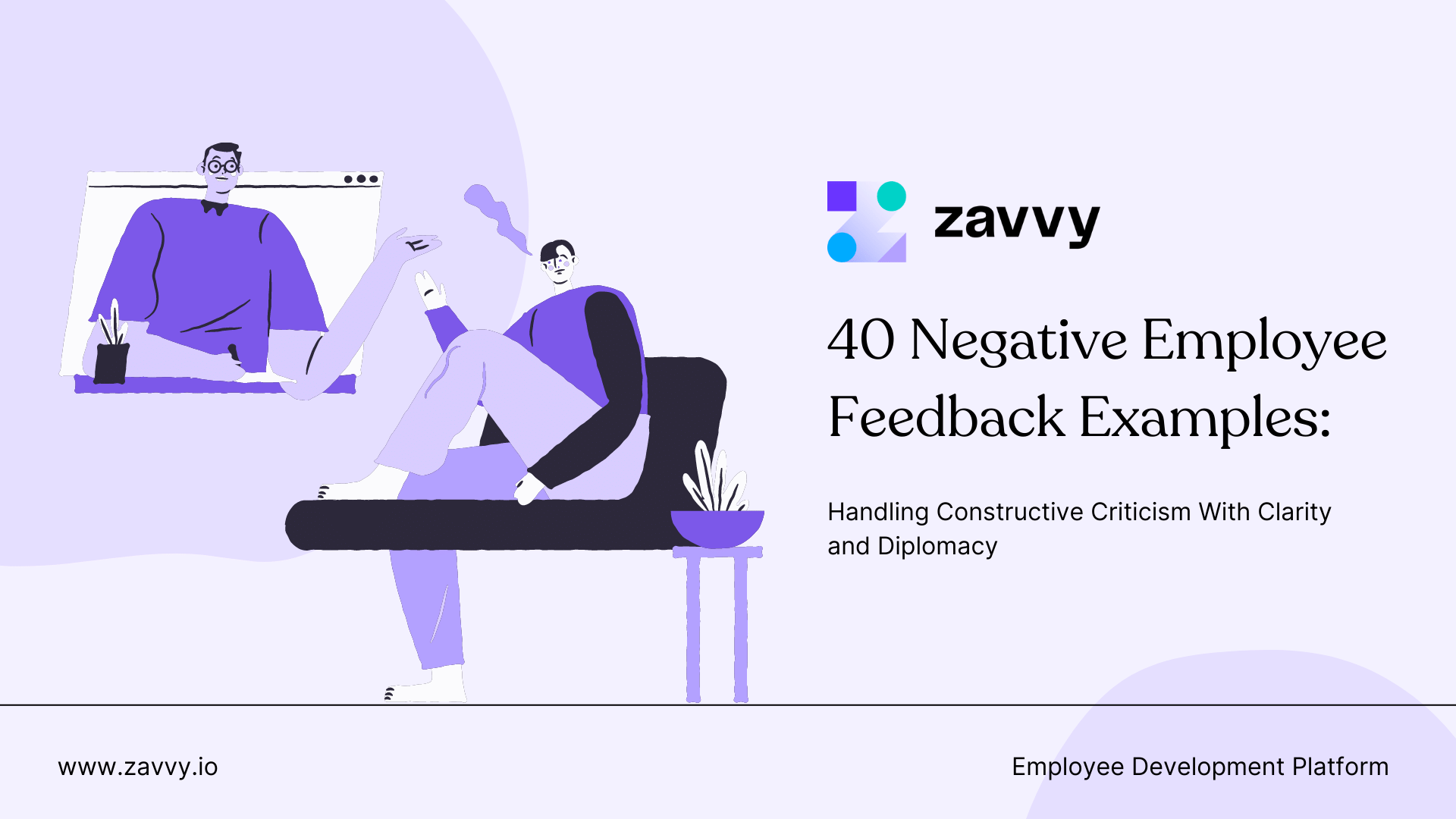
Alexander Heinle
Alex is a marketer at Zavvy. On this blog, he mainly shares insights gained from discussions with selected experts and from helping our customers set up and improve their onboarding or learning programs.


It's never easy to deliver negative feedback in a performance review, but it's an integral part of helping your employees grow.
92% of HBR survey respondents believe "negative (or 'redirecting') feedback, if delivered appropriately, is effective at improving performance."
That said, there's a right way and a wrong way to go about it.
Simply put, your goal should be to deliver effective feedback that is both
Together with our curators, we have created a library of actionable digital marketing resources. Personalized to your team's needs.

Constructive feedback is also known as redirecting feedback.
This means that you focus on offering corrective suggestions for improvement rather than simply criticizing an employee's negative behavior or performance.
All types of feedback should be
For example, rather than saying, "you're lazy," you might say, "I noticed that you took longer lunch breaks last week than you usually do. In the future, I'd appreciate it if you could keep your lunch breaks to 30 minutes."
Feedback that is not constructive can be demotivating and even harmful.

Negative feedback overlaps with constructive feedback in that it's not focused on accomplishments so much as on identifying areas for improvement.
There's an art to both delivering and receiving negative feedback. But without harmony in this exchange, it can lead to bad feelings and even cause someone to quit their job. In this employee feedback statistics roundup, Gallup reports that only 10.4% of employees felt engaged after receiving negative feedback on the job. Worse still, 4 out of 5 employees look for a new job elsewhere due to negative feelings following managerial feedback.
Negativity bias in psychology refers to our tendency to give more weight to negative information than positive information. In other words, we're more likely to remember our failures than our accomplishments.
This tendency can significantly impact how employees perceive and react to feedback.
For example, if you receive 10 pieces of feedback and 9 of them are positive, but 1 is negative, the negative feedback is likely to have a much stronger impact on you than the positive feedback.
Leaders must be aware of negativity bias and make a conscious effort to counter it to ensure morale remains high. Your aim should be to deliver a balanced mix of positive and negative feedback.

There are a few important things to keep in mind when passing negative feedback on to your team members.
When critiquing an employee's behavior or performance, ensure that the feedback is constructive and not demotivating.
Nicola Smith offers Outsourced Human Resources support for business owners & managers.
She explains, "Be specific. Keep in mind the purpose is to improve the performance of your employees."
Feedback that starts with "you" can be confrontational.
For example, "you're always late" is more likely to provoke a defensive reaction than "I noticed that you were late to work today."
Describe the action or behavior you want to avoid, for example, interrupting each other during meetings. Then offer suggestions to demonstrate how your feedback recipient could improve their participation in group discussions.
Cut words like "always" and "never" out of your feedback. These absolutes are rarely accurate, and they also tend to be demotivating.
The way you say something is often just as important as what you say. When delivering negative feedback, it's important to be aware of your tone of voice and body language. If you come across as angry, judgmental, or sarcastic, your feedback will be less effective.
This popular performance review technique focuses on sandwiching negative feedback in the middle of two positive pieces of feedback.
"Taking time to plan what you're going to say and how you're going to say it beforehand can make or break the successful delivery of negative feedback,"
says David Levine, former Chief of Staff at the White House Office of Administration.
Ready to dish out some constructive criticism and redirect your team towards better behavior? We've divided negative feedback example phrases into 7 main categories to make it easy to work these into your performance reviews. Check out phrases in the following categories:

Communication skills are essential in every work environment.
Effective communication skills are integral to maintaining healthy relationships, whether communicating with colleagues, customers, or friends. Well-connected teams see a productivity increase of 20-25%, and 97% of employees report that communication impacts their task executions on a daily basis.
Here are some negative feedback example phrases that you can use:
Interpersonal skills are the soft skills we use to interact with others.
They include active listening, empathy, and social skills. If you're giving feedback to an employee about their interpersonal skills, here are some negative feedback example phrases to use:
Being able to identify and solve problems effectively helps keep the business's wheels well-oiled and running smoothly.
In fact, the World Economic Forum Future of Jobs Report lists critical thinking and problem-solving as top of the list of skills that are a must in the next five years. If you're offering corrective guidance to an employee about their problem-solving skills, here are some negative feedback example phrases to use:
Employees who are aligned with your company culture and values are more likely to be engaged and productive.
A Slack State of Work report found that 90% of aligned employees understand how to be successful within the organization and 75% feel empowered to make strategic business decisions. If this is an area your team members need support with, consider the following phrases:
Employee motivation can be a challenge, with only 15% of employees worldwide falling within the 'engaged' category.
But it's important to find ways to keep your team motivated to meet your productivity and retention goals.
A recent survey of almost 2,000 employees found that the average office worker is productive for just 2 hours and 53 minutes of the working day. And the impact of video conferencing and collaboration tools is costing as much as $1,250 per employee per month in wasted time. Encourage your employees to work smarter by making it clear you're there to offer support while giving them the space to find their own solutions.
International Keynote Speaker Shola Kaye explains,
"Employees aren't the only ones who can receive feedback about their performance at work. As a manager or business leader, it's important to receive feedback from your employees so you can understand how you're doing and what you need to do to improve.
While every manager hopes for positive feedback, they may still receive negative feedback from time to time, and it's how they respond to that feedback that can really make the difference."
This type of one-to-one feedback is similar to any other employee performance review in your organization.
The only difference is there will be a focus on performance management and leadership skills to ensure the feedback recipient is nurturing the talent under their wing.
360 review processes are a two-way street, so leaders will also receive feedback from their own direct reports or employees within the organization.
Here are some examples employees can use in their real-life reviews:

If it's challenging to dish out critical feedback, receiving it is even more difficult. But if you can learn to accept and receive negative feedback in a constructive way, it can be a valuable tool for helping you grow and develop in your career.
In most cases, the person giving the feedback wants to see you thrive, so keep that in mind even if you're feeling wounded.
Career Coach Ekua Cant says,
"Clarity can be gained by getting constructive feedback. The problem I have found is sometimes I am guilty of some of these listening sins too:
Here are some examples of how to respond to negative feedback.
Redirecting (negative) feedback should form part of any continuous feedback cycle. It's just as important as reinforcing (positive) feedback in promoting growth and opportunities in your company culture.
The main takeaway? Remember, the negativity bias means your words will impact the feedback recipient far more than positive reviews. So, always give negative feedback with sensitivity and a clear purpose in mind.
Zavvy's employee feedback tool makes giving and receiving feedback easy.
Our platform is highly customizable, scalable, and you can tailor it to your specific needs. Learn more by getting in touch with Zavvy to arrange a demo.
Upskill your team every week with the best contents and personalized recommendations.

It's never easy to deliver negative feedback in a performance review, but it's an integral part of helping your employees grow.
92% of HBR survey respondents believe "negative (or 'redirecting') feedback, if delivered appropriately, is effective at improving performance."
That said, there's a right way and a wrong way to go about it.
Simply put, your goal should be to deliver effective feedback that is both
Get a demo!
We'll be happy to show you around and answer all your questions.
Trusted by innovative companies



We'll be happy to show you around, answer your questions, or arrange a free trial.
Erhalten Sie eine kostenlose Demo unserer Onboarding-Software.
Vertraut von



Your Training & Development Strategy - Solved in 1 Tool.
Trusted by innovative companies



We'll be happy to show you around, answer your questions, or arrange a free trial.
Learn how Zavvy helps you drive performance, development, and engagement.
Trusted by innovative companies



We'll be happy to show you around, answer your questions, or arrange a free trial.
We'll be happy to show you around and answer all your questions.
Trusted by innovative companies



We'll be happy to show you around, answer your questions, or arrange a free trial.
Gerne zeigen wir Ihnen ganz unverbindlich unsere Plattform im Detail.
Vertraut von modernen Unternehmen



Get a demo!
We'll be happy to show you around and answer all your questions.
Trusted by innovative companies



We'll be happy to show you around, answer your questions, or arrange a free trial.
Erhalten Sie eine kostenlose Demo unserer Software für Mitarbeiterenwicklung und Training.
Moderne Unternehmen
setzen auf Zavvy


